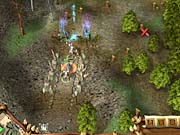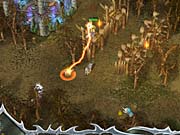Once Upon a Knight must have been imagined as something other than a typical real-time strategy game. An obvious amount of effort went into fleshing out the RTS and RPG elements in two separate modes, each with its own campaigns, but the resulting hybrid isn't a good example of either type of game. Apart from odd attempts at humor that are hard to ignore, the story execution falls flat, the scenarios are tediously scripted, and the skirmish mode is terribly limited.
The far-off, long-ago fairy-tale kingdom of Prince John is a land troubled by the despicable lord Valtamand. The prince, who is naturally all things good and honorable, was kidnapped by Valtamand, and that predictable premise sets up both a series of RPG scenarios in which a single adventurer attempts to free him and a real-time strategy campaign that has you controlling the prince in his effort to regain power after escaping. The modes are completely distinct--like two thematically similar games that happen to share the same look, monsters, and control scheme--and if the long campaigns don't happen to offer enough material, there's multiplayer support for both.

After navigating all these options at the main menu, you'll find that the real-time strategy campaign has the most to offer, which isn't surprising given Reality Pump's background as the creator of the Earth 2150 series. The main gimmick is that the game's economy is based on milk produced by grazing cows, and for some reason, this is supposed to embody the game's overall humor. In reality, it takes quite some time for the campaign to even work up to a typical base-building mission, as the early chapters predominantly focus on quests for items and puzzles that most often involve searching the map--sometimes above and below ground--for buttons to open gates. There are usually enough hints in the in-engine cutscenes or the goal list so that the quests are incredibly straightforward, and marks often appear on the minimap to make things even clearer.
These missions are typically quite short and provide more than enough time to get accustomed to the controls and rotatable 3D camera. Yet, the pacing is uneven, and suddenly you're in the middle of an early showdown with Valtamand in a long multipart mission. Even combat-focused scenarios like this often include the largely annoying puzzle elements, though. Nevertheless, these relatively action-packed missions are the best the game has to offer, and the larger battles can involve dozens of units on either side. Adventuring has a number of important secondary benefits, providing ample opportunity for units--most importantly, Sir John and accompanying main characters--to gain experience and significantly upgrade their weapons and armor. When it works well, the mix of questing and combat helps cover the relatively slow speed of unit and base building, something that's much more apparent in skirmishes.
The design of the core strategy game is simplistic. Docile cows slowly graze on green patches of grass, and the process can be accelerated by having a cowherd nearby, a tiny boy who can also steal cows from opponents. Then there's a set of basic units, including workers, archers, spearmen, and warriors, which can make up the bulk of your army as long as you create enough of the huts and barracks that house them. The special units are truly a motley crew: the heavily armored knight, broomstick-riding witches (the only flying unit), and three different spellcasters. And finally, there's the rolling-pin-wielding mother-in-law who can very quickly capture enemy buildings and speed up workers. The spell units have some potent abilities, like the priestesses' ability to convert enemy units, but they are incredibly vulnerable to normal weapons. While there's a basic formation system to keep warriors in front and weaker units behind, the fact that frontline units speed up, sprinting into battle, can make it difficult to keep the physically weaker units alive.
The main difference with the RPG mode comes in the addition of inventory and skill systems, which aren't as involved as what you'd expect from a dedicated action RPG, but they do add some options for developing your character as you gain experience levels. The seven characters are straight out of the main game and start off weak enough that fighting packs of wolves, bears, and skeletons can be a challenge even on the easier setting. Making it through solo battles means popping health potions and taking advantage of the many magical health stations scattered around, but there are a variety of hirelings available to help you out if you have the cash.
The RPG scenarios take place on dense maps packed with random encounters and villagers ready to sell a variety of items and hand out quests. The obvious focus of any action RPG is on fighting monsters and on building up your character, but unfortunately the game's engine is better suited to RTS-style battles. A character can easily find its path from one edge of the map to the other, but doesn't move responsively in close combat. Clicking on an enemy to have a spellcaster attack with a lightning staff may result in the character dancing around, wasting time as a monster closes in, instead of firing at the weapon's maximum distance. On the other hand, melee combat is terribly automatic, so there's not much direct action. The maps are also so tightly packed--much more than the RTS maps--that they provide little room for satisfying exploration and seem less like a part of a fairy-tale world than an abstract exercise.

Even if the story, and the long-winded cutscenes that tell it in both parts of the game, wasn't dull and cliché-ridden, the leaden voice acting and uneven tone would still weigh it down. Most of the developer's comedic effort apparently went into writing odd things for units to say as they move around the map. While Sir John is almost competently voiced, he's given odd sayings like "We shall not stand for anything the enemy has to offer" and "We're just standing around and time is running away," which are more nonsensical than anything. And even if these voice clips don't annoy you by the end of the three main campaigns, they're rather more painful in the RPG mode, since you only hear the limited selection of things one unit has to say as movement orders are confirmed. By comparison, the graphics may seem quite good, particularly the water effects. But even this technical proficiency is undermined by maps that just aren't very interesting to look at.
In a fairy-tale world, Once Upon a Knight could be recommended for offering two games in one box, but in reality, neither is very good. The story missions may take quite some time to play through, but there's little to motivate you to do so. And even the skirmish mode, which you might expect to highlight the game's strategy strengths, is hobbled by poor AI. A single computer-controlled player isn't much of a challenge, and multiple CPU players will gang up on you without fighting each other. Furthermore, at this time, it's quite difficult to find anyone to play a multiplayer game with on the Earthnet matchmaking service. It's hard to find any part of the game that's truly entertaining.